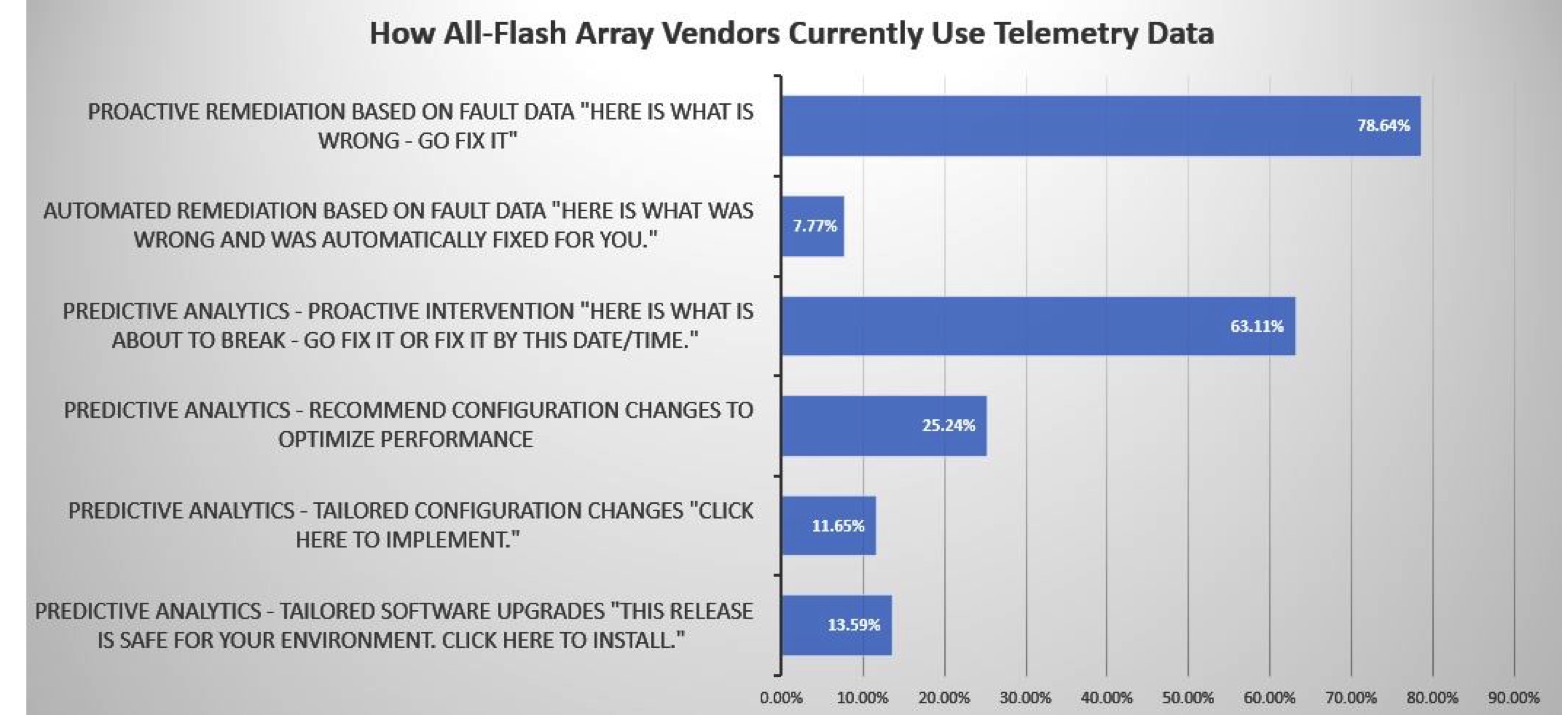Predictive Analytics in Enterprise Storage – DCIG
More than just "highfalutin mumbo jumbo"
This is a Press Release edited by StorageNewsletter.com on March 26, 2018 at 2:34 pm This article was published on March 22, 2018 and written by Ken Clipperton, managing analyst, DCIG, LLC.
This article was published on March 22, 2018 and written by Ken Clipperton, managing analyst, DCIG, LLC.
Predictive Analytics in Enterprise Storage:
More Than Just Highfalutin Mumbo Jumbo
Enterprise storage start-ups are pushing the storage industry forward faster and in directions it may never have gone without them.
It is because of these start-ups that flash memory is now the preferred place to store critical enterprise data. Start-ups advanced the customer-friendly all-inclusive approach to software licensing, evergreen hardware refreshes, and pay-as-you-grow utility pricing. These start-up-inspired changes delight customers, who are rewarding these start-ups with large follow-on purchases and Net Promoter Scores (NPS) previously unseen in this industry. Yet the greatest contribution start-ups may make to the enterprise storage industry is applying predictive analytics to storage.
Benefits of Predictive Analytics for Enterprise Storage
The end goal of predictive analytics for the more visionary start-ups goes beyond eliminating downtime. Their goal is to enable data center infrastructures to autonomously optimize themselves for application availability, performance and TCO based on the customer’s priorities.
The vendors that commit to this path and execute better than their competitors are creating value for their customers. They are also enabling their own organizations to scale up revenues without scaling out staff. Vendors that succeed in applying predictive analytics to storage today also position themselves to win tomorrow in the era of software-defined data centers (SDDC) built on top of composable infrastructures.
To some people this may sound like a bunch of ‘highfalutin mumbo jumbo’, but vendors are making real progress in applying predictive analytics to enterprise storage and other elements of the technical infrastructure. Vendors and enterprises are achieving meaningful benefits.
These benefits include:
• Measurably reducing downtime
• Avoiding preventable downtime
• Optimizing application performance
• Significantly reducing operational expenses
• Improving NPS
HPE Quantifies the Benefits of InfoSight Predictive Analytics
Incumbent technology vendors are responding to this pressure from start-ups in a variety of ways. HPE purchased Nimble Storage, the prime mover in this space, and plans to extend the benefits of Nimble’s InfoSight predictive analytics to its other enterprise infrastructure products.
HPE claims its Nimble Storage array customers are seeing the following benefits from InfoSight:
• 99.9999% of measured availability across its installed base
• 86% of problems are predicted and automatically resolved before customers even realize there is an issue
• 85% less time spent managing and resolving storage-related problems
• 79% savings in OpEx
• 54% of issues pinpointed are not storage, identified through InfoSight cross-stack analytics
• 42 minutes: the average level three engineer time required to resolve an issue
• 100% of issues go directly to level three support engineers, no time wasted working through level one and level two engineers
Current State of Affairs in Predictive Analytics
HPE is certainly not alone on this journey. In fact, vendors are claiming some use of predictive analytics for more than half of the all-flash arrays DCIG researched.
Click to enlarge
Telemetry Data is the Foundation for Predictive Analytics
Storage array vendors use telemetry data collected from the installed product base in a variety of ways. Most vendors evaluate fault data and advise customers how to resolve problems, or they remotely log in and resolve problems for their customers.
Many all-flash arrays transmit not just fault data, but extensive additional telemetry data about workloads back to the vendors. This data includes IO/s, bandwidth, and latency associated with workloads, front end ports, storage pools and more. Some vendors apply machine learning algorithms to data collected across the entire installed base to identify problem scenarios and optimization opportunities.
Predictive Analytics Features that Matter
Tailored software upgrades eliminate outages based on the vendor seeing and fixing a problem caused by a software update. They avoid delivering that update to similar sites until they have resolved the issue.
Tailored configuration changes eliminate outages or application performance issues based on the vendor seeing and fixing problems caused by misconfigurations. The vendor deploys the fix to other sites that run the same applications, eliminating potential problems.
Recommending configuration changes enhances application performance at a site by comparing the performance of the same application at similar sites, discovering optimal configurations, and recommending configuration changes at each site.
Proactive interventions identify something that is going to create a problem and provide guidance in how to avoid the problem. A wide range of interventions are possible including identifying the date when an array will reach full capacity or identifying a network configuration that could create a loop condition.
Predictive Analytics is Significant Yet Largely Untapped Opportunity
Vendors are already creating much value by applying predictive analytics to enterprise storage. Yet no vendor or product comes close to delivering all the value that is possible. A huge opportunity remains, especially considering the trends toward software-defined data centers and composable infrastructures. Reflecting for even a few minutes on the substantial benefits that predictive analytics is already delivering should prompt every prospective all-flash array purchaser to incorporate predictive analytics capabilities into their evaluation of these products and the vendors that provide them.














 Subscribe to our free daily newsletter
Subscribe to our free daily newsletter

